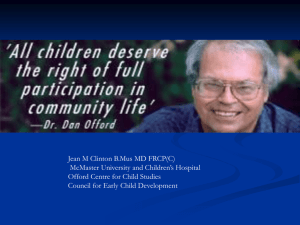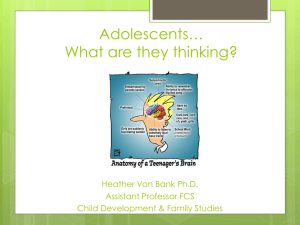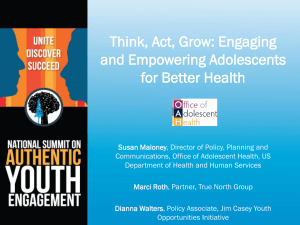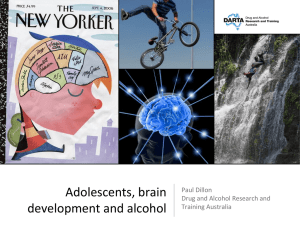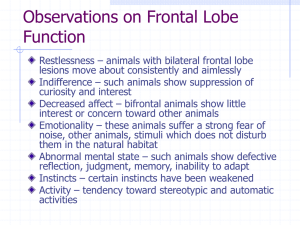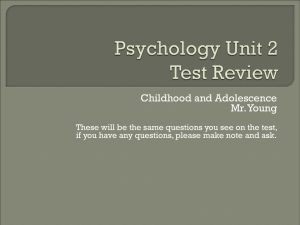Current Trends in Understanding the Adolescent Brain
advertisement
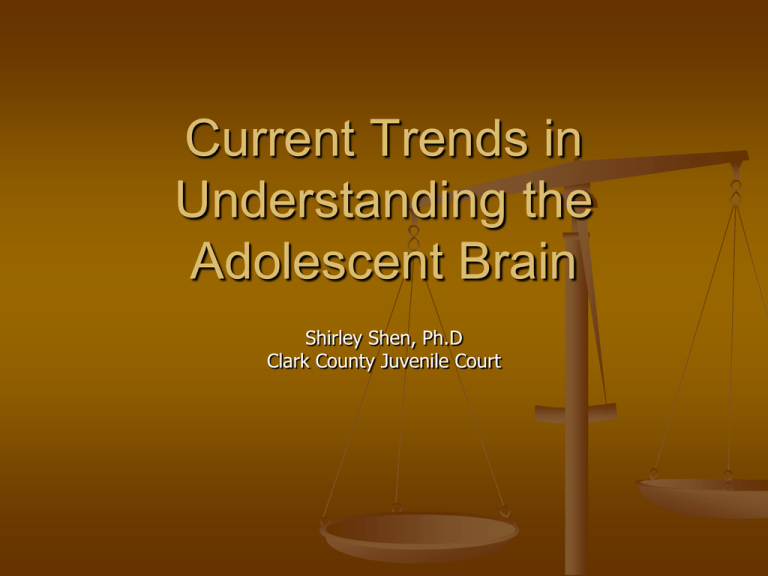
Current Trends in Understanding the Adolescent Brain Shirley Shen, Ph.D Clark County Juvenile Court Maturation of the teen brain Something more organized that looks like this.. Like a remote control Cross section of brain Neuron Stages of brain development The infant is born with an overproduction of neuron, much more than the adult brain. Neural connections, however, are not established during birth. Experiences in the child’s environment leads to either reinforcement (wiring) of the neural connections or elimination of the neural connection (pruning) NIMH Study Dr. Jay Giedd—National Institute of Mental Health Began studying the brain of normal children and teenagers every two years with a fMRI Implications of Dr. Giedd’s findings of the adolescent brain Dr. Giedd found that prior to adolescence, there is a thickening in the grey areas of the frontal lobe. There are also profound changes in the amygdala and also in the nucleus accumbens Frontal Grey Matter Development in the Adolescent Brain Frontal Lobe Function of Frontal Lobe Responsible for: Executive functioning tasks such as: planning strategizing organizing Attention functioning: maintaining attention shifting attention Examples of Functional Impairments in Frontal Lobe Lesions Short term memory is impaired with easy distraction. Impairments in divergent thinking (when there are multiple correct answers). Examples of Functional Impairments in Frontal Lobe Lesions Impaired strategy formation and planning, especially in unfamiliar situations. There is inappropriate behavior with difficulty using social cues and information to direct, control, or change personal behavior. Inhibition impaired. The frontal lobe functions as the CEO. The adolescent is just learning how to use the prefrontal cortex. However, it is not always very successful at it. When the frontal lobe is vulnerable When emotions are called on first to solve a problem During times of peer influence. What is the anatomical reason for this The brain is being reorganized during adolescene The more primitive portions of the brain, such as the sensorimotor region and the emotional regions are already developed Beatrice Luna-University of Pittsburg Adolescent risk taking Design- Asked both adults and adolescent to not look at a light placed in a brain scanner. Findings of Study Adults Able to not look at the light Used several parts of brain to manage the task Teens Able to not look at the light Solely used the frontal lobe to complete this task MRI Study by Dr. Yurgelun-Todd N=19 Suggestive that the prefrontal cortex attenuates or monitors what happens in the amygdala Implications Teens can use their frontal lobe. However, as they are learning to use it, they are using it even to do very easy tasks Teens are not good managers of their frontal lobe. It is as if the manager makes himself take on the role of all his employees. Amygdala Function of the Amygdala Emotional center of the brain It has been suggested that the amygdala functions to associate sensation with reward or punishment. The amygdala does seem to be closely associated with the feeling of fear Amygdala and the Adolescent Brain Adolescents tend to use their Limbic System more often in the decision making process, since their Frontal Lobes are not fully developed. The Amygdala, part of the Limbic System, is responsible for impulse reactions, emotional reactions, fear, and is also used in the decision-making process of adolescents. Implications of Amygdala on Adolescent Behaviors Results in adolescents making more decisions based on emotional reactions rather than reasoning. Less capable ability to weigh long term consequences. Developing adolescents tend to use their Amygdala when responding to other people’s emotions, yielding more reactionary, less reasoned perceptions of situations than adults. Teen brain Adult brain Nucleus Accumbens Mortality Rates in Adolescents in the U.S. 1979-1988 Approximately three fourths of the more than 40,000 deaths each year among persons aged 10-24 years in the United States are related to preventable causes motor-vehicle crashes (37%), homicide (14%), suicide (12%), and other injuries (e.g., drowning, poisoning, and burns) (12%). Function of Nucleus Accumbens Directs motivation Responsible for how much effort an organism will expend in order to seek reward Also often referred to as the brain’s reward system Has significant implications in the reward system for drugs in the brain Studies of adolescent response in risk takingWheel of fortune task Adolescents took significantly more risks than did adults and were Adolescents were happier when they won money, but were less upset than adults when they lost. In response to feedback, adolescents activated the nucleus accumbens more than did adults, while adults engaged the amygdala and PFC more than did adolescents. Teens Perception of Self Also a function of brain development Who Am I ????? Who I am depends on who my friends think I am…. My Friends tell me who I am socially Social Influences Who Am I ????? Who I am depends on who my parents think I am…… My parents tell me who I am academically Dr. Jennifer Pfeifer-University of Oregon Study Group Method • 12 (11-13 year olds) • 12 (22-30 year olds) • MRI Images of the brain in response to questions of individuals’ perception of themselves Two separate types of questions were asked while subjects were put in an fMRI scan. What do I think of myself……(direct self apprasial) What others think of me……..(reflected self apprasial) Study Findings When asked what others thought of you, both teens and adults used the medial prefrontal cortex and also the temporal parietal areas of the brain. However When asked how adults and teens think of themselves, teens continued to use the same region of the brain, suggesting that teen’s self appraisal is tied into what they believe others think of them. Studies on brain vulnerability to drugs and alcohol as it relates to risk taking Susan Anderson-Harvard Medical School Placed juvenile and adult rats in situation where they were able to have access to cocaine. Young and old rats opted not to be in that environment, but adolescent rats tended to be immensely attracted to the situation. Scott Swartzwelder-Duke University 7 million youngsters binge drink once a month Effects of alcohol has lasting impact on the adolescent brain, particularly in the area of the hippocampus which is responsible for memory. Teen brains do not recover as quickly after drinking as adults-demonstrated in memory tests 3-weeks post last binge episode. While their brains are much more vulnerable to alcohol, it has less sedating effects. Teens don’t get tired after drinking the same way that adults do. Teens are also less vulnerable to balance problems and hangovers from drinking Alcohol’s affect on the hippocampus Receptors are activated by the neurotransmitter glutamate and allow calcium to enter neurons, setting off a cascade of changes that strengthen synapses, by helping to create repeated connections between cells, aiding in the efficient formation of new memories. But at the equivalent of one or two alcoholic drinks, the receptors' activity slowed, and at higher doses, they shut down almost entirely. What Do We Know Drinking during the teen years significantly increases a youngster’s chances of becoming alcoholic in adult life. Drinking, even moderately in teen years significantly damage the hippocampus. The long term damage of drinking in adolescence is significantly more than in the adult. These damages are long term How brain research affects legal ruling for adolescents Jackson v. Hobbs mandatory life-without-parole sentences for all children 17 or younger convicted of homicide are unconstitutional “Mandatory life without parole for a juvenile precludes consideration of his chronological age and its hallmark features — among them, immaturity, impetuosity, and failure to appreciate risks and consequences,” Justice Kagan Relationship Relationship Relationship Have concrete specific goals and tools that will work for one or two days. Don’t make goals so long that it is not salient Make sure that kids are appropriately diagnosed. Most youths in detention have contributing academic, learning, mental health or a combination of all of them Make doing well more exciting than the crime. Encourage exercise-exercise increased plasticity to brain development. With increased opportunities, the brain will learn to do it better and quicker. References 1 Giedd JN, Blumenthal J, Jeffries NO, et al. Brain development during childhood and adolescence: a longitudinal MRI study. Nature Neuroscience, 1999; 2(10): 861-3. 2 Rapoport JL, Giedd JN, Blumenthal J, et al. Progressive cortical change during adolescence in childhood-onset schizophrenia. A longitudinal magnetic resonance imaging study. Archives of General Psychiatry, 1999; 56(7): 649-54. 3 Thompson PM, Giedd JN, Woods RP, et al. Growth patterns in the developing brain detected by using continuum mechanical tensor maps. Nature, 2000; 404(6774): 190-3. 4 Sowell ER, Thompson PM, Holmes CJ, et al. In vivo evidence for post-adolescent brain maturation in frontal and striatal regions. Nature Neuroscience, 1999; 2(10): 859-61. 5 Baird AA, Gruber SA, Fein DA, et al. Functional magnetic resonance imaging of facial affect recognition in children and adolescents. Journal of the American Academy of Child and Adolescent Psychiatry, 1999; 38(2): 195-9.
